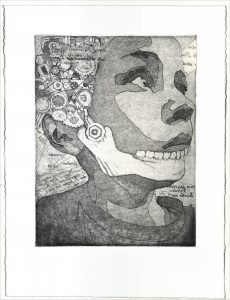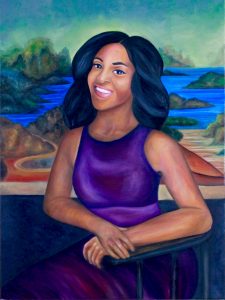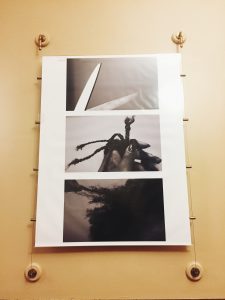Published on Feb. 6, 2017
The Visual Art and Design Showcase featured MU undergraduate student art and design projects from Jan. 30 to Feb. 3 in Jesse Hall.
Participating students applied to be able to enter the showcase and were then selected by a faculty committee. They were eligible to compete for $10,000 in professional development funds. Project categories included art, architecture, digital storytelling, journalism, textile and apparel management, and theater. Once selected, students were assigned mentors to help them make plans for project displays.
This year, three Honors College students participated in the showcase. These students displayed a wide array of mediums and exhibited a multitude of artistic and design talents through their project pieces.
Get to know Jessie Donovan, JoMerra Watson and Kayla Myers, and see their work!
Jessie Donovan
Year: Senior (5th Year)
Hometown: Wentzville, Missouri
Medium: Printmaking
Project Title: Vulnerable and Variable

Vulnerable and Variable by Jessie Donovan.
Why did you decide to enter your project?
“I decided to enter a project because I have been working on a body of work for about a year and a half, and I am very excited about my images and concept. I wanted to share them and give other people a chance to see them as well. I also knew this would be invaluable professional practice experience.”
What kind of piece did you submit, and what did you title it?
“I submitted four pictures of my etchings and I titled the series “Vulnerable and Variable.” The individual prints do not have titles and are not editioned.”
Why did you choose printmaking as your medium for this project?
“Printmaking is an art with an important history, and its invention led to the boom in the spread of information and science. People could then print and edition an idea in multiples, giving rise to the authority of the printed word. In my series, I draw images reminiscent of the styles of the first anthropological and botanical classifications. These are accompanied by medical documents and criminal convictions. I don’t edition these prints and I never allow the full texts to surround my images because these authoritative texts are constantly changing throughout time, and I want to reject the idea that these laws and classifications have full authority. This idea would be less successful if I used another medium because the subject matter relies on the history and practice of printmaking.”
What is the meaning behind your project?
“My project is a way for me to reject the authority of the printed word and to diminish the practice of classification in the modern world. Our classifications of illnesses and criminal law are always changing, and that reveals of incredibility of these categorizations. Every print I create has different text accompanying it, but the images are always the same.”
Who was your mentor for this project? How did he or she help you along the way?
“My mentor, Chris Daniggelis, is an inspiring and motivating professor, and his encouragement aided in my comprehension of printmaking techniques. He also always pushes for his students to be considerate and detailed in our subject matter, and place ourselves in the world of art by knowing history and our contemporaries. He reviewed my artist statement and has had discussions about my work since I made the very first print of this series.”
What did you get out of participating in this showcase?
“I was already familiar with framing and preparing individual prints for showing but I had not had any formal experience with talking about my work. I think this is great experience for every designer or artist because we often must talk about ourselves and our work in the professional realm. I was also a great chance to connect with other classmates in the show and see what they have been working on.”
JoMerra Watson
Year: Junior
Hometown: Chicago, Illinois
Medium: Painting
Project Title: Rewrite

Rewrite by JoMerra Watson.
Why did you decide to enter your project?
“I decided to enter a project due to encouragement from some of my art professors. It was also another chance to display my work, so I figured there was no harm in at least applying.”
What kind of piece did you submit, and what did you title it?
“I submitted 3 separate oil on canvas paintings. The overall project is titled Rewrite.
Why did you choose painting as your medium for this project?
“Painting is my primary area of concentration for many reasons, but the main two would probably be the I enjoy the range in which I’m able to apply color, and the long standing history it has within art-media context.”
What is the meaning behind your project?
“The series seeks to take well-known paintings throughout art history and replace the subject with a Black female body to address various issues such as police brutality, standards of beauty and what it means to be Black and a woman in certain spaces within a contemporary Black youth culture sense. It also simultaneously is seeking to address issues about the representation, or lack thereof, of Black people throughout art history.”
Who was your mentor for this project? How did he or she help you along the way?
“Alexis Callender was my mentor. She got me to really think about the context in which I was creating my work, especially since I was drawing from historical references and using that to talk about contemporary issues.”
What did you get out of participating in this showcase?
“I got to challenge myself to experiment with a few different ways to apply paint. It was also nice to see my work displayed in a space that we as students occupied during the fall 2015 semester to make our voices heard about race-related concerns. Participating in that helped push my work into the direction that it’s been taking since.”
Kayla Myers
Year: Junior
Hometown: Memphis, Tennessee
Medium: Photography
Project Title: Curls

Curls by Kayla Myers
Why did you decide to enter your project?
“I entered a project into the showcase because my mentor, Katina Bitsicas, mentioned the showcase to me toward the middle of last semester. She helped me figure out which work I did in her digital storytelling production course that she wanted me to enter, and it was her encouragement that led to me entering the showcase.”
What kind of piece did you submit, and what did you title it?
“My piece, Curls, is a photographic work about the process of taking down African hair braids and returning to my natural afro.”
Why did you choose photography as your medium for this project?
“Photography is the digital medium that I feel most comfortable with, and it’s the main way that I express myself artistically. The original assignment was a photography autobiography, and one of the most important parts of myself is my hair.”
What is the meaning behind your project?
“Curls is a representation of what it means to have black hair. Often times, I wear braids as a protective style for my natural hair, and the diversity of black hair has led to a lot of the confusion surrounding the hair of black women and its acceptance in society. My work seeks to showcase to people what the process is actually like, and illuminate others on some of what the experience of black hair is like. Our culture often has a hard time accepting beauty outside of euro-centric processes or standards, and I really wanted to highlight the beauty of black hair through black and white photography.”
Who was your mentor for this project? How did he or she help you along the way?
“Katina Bitsicas, my digital storytelling professor, really helped guide me through the process and she is the main reason as to why I submitted my work into the showcase in the first place. She has been such a great help to me with my creativity, and in growing in my skills as a digital storyteller.”
What did you get out of participating in this showcase?
“It’s really been such a validating experience for me in terms of knowing that I can put my work out there, and it has been really helpful in learning how to talk about my creative work. It is a very different thing to discuss creative work in a way that allows others to understand your process, what your work means, and why it should be meaningful to them. The showcase has really given me a better idea of how to do that, and it’s made me even more excited to create works and to submit work next year as well.”